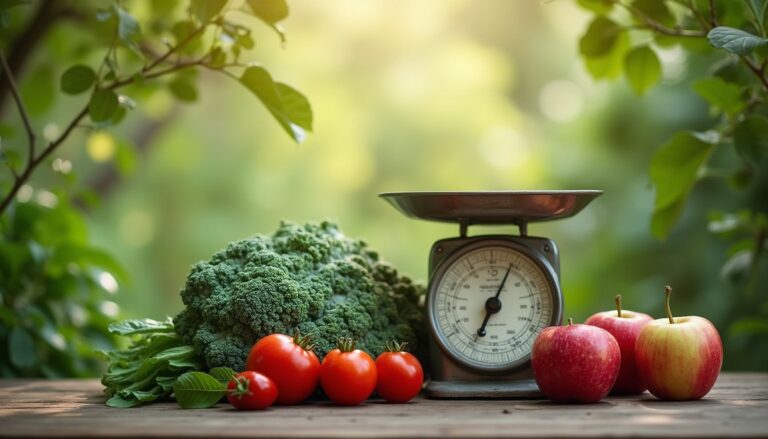Essential Tips For Improving Health And Nutrition
Our Nutrition Assistant AI Suite will transform your body. You will lose fat, get toned, and build muscle. Gain confidence and optimal health.
Healthy eating can feel confusing, especially on busy days. You are not alone if you struggle to build a balanced diet or pick the right foods. Nutrition shapes your energy, mood, and long-term risk for conditions like heart disease and diabetes.
This guide shares clear steps you can use today. You will learn how to follow the Dietary Guidelines for Americans, enjoy more fruits and vegetables, manage portions, cut added sugars, choose better snacks, and make small daily changes that stick.
Start with one or two ideas. Build confidence, then add more.
Key Takeaways
- The Dietary Guidelines for Americans 2020-2025 suggest a variety of fruits, vegetables, whole grains, and lean protein. Keep added sugars under 10 percent of daily calories.
- Meal prepping can save families about 60 dollars per month and supports portion control and fewer fast-food stops.
- Research shows even mild dehydration may trigger headaches and fatigue in kids and adults.
- Children need at least 60 minutes of daily activity. Adults should aim for at least 150 minutes per week to reduce chronic disease risk.
- Vegans and vegetarians should monitor vitamin B12, iron, calcium, and vitamin D to prevent nutrient gaps.

Why Are Health and Nutrition Important?

Food choices add up. Eating well helps you feel and function better, both physically and mentally. It also supports your immune system and lowers the chance of chronic disease.
What Are Health and Nutrition?
Nutrition means giving your body what it needs to work well. Meals provide calories and nutrients. These include carbohydrates, protein, fat, vitamins, minerals, and water.
Nutrients build and repair tissues and protect your cells. A balanced diet can lower the risk of heart disease, type 2 diabetes, high blood pressure, obesity, stroke, and some cancers.
Good nutrition is one of the most powerful tools we have to prevent chronic disease.
Health is more than the absence of illness. It includes strength, energy, and emotional balance. Eating well supports daily life at every age.
Vitamins C and D support immune defenses. Antioxidants help limit damage from harmful molecules called free radicals. Each smart choice moves you closer to better health.
How Does Proper Nutrition Affect Overall Well-Being?
Daily eating patterns support your brain, muscles, bones, nerves, and immune system. Leafy greens like cabbage and broccoli deliver key vitamins and minerals. These micronutrients support growth in children and reduce the risk of malnutrition.
Omega-3 fatty acids from fish lower heart disease risk. Dietary fiber in whole grains improves digestion and helps control blood sugar. Keeping added sugars, saturated fat, trans fat, and sodium low can lower cholesterol and support healthy blood pressure.
Better nutrition improves energy and mood. People who eat balanced meals report higher quality of life than those who skip meals or rely on heavily processed foods. B vitamins support nerves and brain function. Vitamin D supports bone strength. Folate, a B vitamin, is extra important during pregnancy for mother and baby.
Strong habits formed early can protect your circulatory system as you age. This lowers the risk of diabetes, osteoporosis, cancer, and cardiovascular disease.
Understanding Balanced Nutrition
Balanced nutrition gives your body enough energy and nutrients to power daily life. Learning how to build a balanced plate makes healthy choices simpler.
What Roles Do Carbohydrates, Proteins, and Fats Play?
Carbohydrates fuel your day and support focus at school or work. Choose sources like whole grains, beans, peas, and fruit. These foods also bring fiber that supports digestion and heart health.
Protein builds and repairs tissues like muscle and skin. Plant proteins, including soy foods, lentils, and nuts, provide protein with less saturated fat than many animal foods.
Healthy fats from olive oil, seeds, fish, and nuts support your heart. They help improve cholesterol levels. Public health agencies suggest choosing liquid oils more often than solid animal fats.
Getting the right mix of carbs, protein, and fat supports weight goals and reduces the risk of non-communicable diseases.
Vitamins and minerals also matter. See why they complete the picture.
Why Are Vitamins and Minerals Important?
Vitamins and minerals are micronutrients. They support tissue repair, immunity, bone health, nerves, and many cell processes. Water-soluble vitamins include vitamin C and the B family. Fat-soluble vitamins include A, D, E, and K. Key minerals include calcium, magnesium, iron, and zinc.
Some conditions affect absorption, such as Crohn’s disease or celiac disease. People who avoid animal foods may need a vitamin B12 supplement, since B12 is mainly found in animal products. Many vegans also monitor iron and zinc.
Health professionals may order blood tests to check your status. People with osteoporosis may need extra calcium and vitamin D. If you avoid dairy, look for fortified soy milk or green vegetables like broccoli or cauliflower.
During high school sports, I felt worn down on a strict low-carb plan. A coach suggested testing my iron and folate. Correcting a folate deficiency helped my energy return quickly.
Meeting daily needs can prevent problems like childhood obesity and supports attention and learning in kids with attention deficit hyperactivity disorder.
How Does Hydration Impact Health?
Nutrients matter, and water does too. Hydration supports appetite control, energy, and clear thinking. Water carries nutrients like sodium and potassium to your cells and helps muscles perform during exercise.
Fluids support your kidneys, remove waste, and regulate temperature. Dehydration can cause headaches and poor focus. Even mild dehydration may lower mood and increase tiredness in adults and children.^1 Try to drink before you feel thirsty.
On busy days, I forget my water bottle. Drinking more during the day gives me steadier energy and clearer focus.
^1 Popkin BM et al., Water Intake Recommendations, Nutrition Reviews 2010;68(8):439–458
Essential Tips for Improving Nutrition
Small daily choices help you build strong nutrition habits. Focus on simple swaps that protect your health and are backed by science.
Why Eat a Variety of Colorful Fruits and Vegetables?
Each color signals different nutrients and protective plant compounds, called phytochemicals. Leafy greens like spinach and kale offer vitamin A, vitamin C, calcium, and anti-inflammatory compounds.
Berries bring fiber and antioxidants that protect your cells. Cruciferous vegetables like broccoli, cabbage, Brussels sprouts, and kale offer fiber and nutrients linked with cancer prevention.
My energy improved when I added different colored fruit each week. Cravings felt easier to manage too.
Try to fill half your plate with colorful produce. This supports a balanced diet, fits with DASH diet ideas, and helps with weight management.
How to Incorporate Whole Grains into Your Meals?
Whole grains provide fiber, B vitamins, and minerals that support heart and metabolic health. They can also help lower cholesterol.
- Start with oatmeal or a whole-grain cereal at breakfast to boost energy and fiber.
- Choose brown rice or quinoa instead of white rice for more fiber and minerals.
- Swap regular tortillas, pasta, or bread for whole-grain versions to reduce chronic disease risk.
- Check ingredients for the word
whole
at the top of the list to spot real whole grains. - Mix grains like barley, farro, or bulgur into soups and salads for variety.
- Use whole-grain flour for pancakes or muffins to support steady blood sugar.
- Snack on unsalted popcorn instead of chips for a higher fiber option.
Once whole grains are in place, lean protein will raise the nutrition score of your meals.
What Are Lean Sources of Protein?
Lean protein helps repair and build body tissues. Good options include chicken, fish, eggs, beans, soybeans, and peas. Fatty fish, such as salmon, trout, mackerel, anchovies, and sardines, provide omega-3 fats that protect the heart.
Yogurt adds protein, calcium for bones, and probiotics for gut health. Swapping red meat for grilled chicken or baked fish reduces saturated fat but keeps meals satisfying.
Plant proteins like beans and soyfoods work well for people managing celiac disease or some autoimmune conditions, because they are naturally gluten free. Varying your protein choices supports broader nutrition.
How to Include Healthy Fats from Nuts, Seeds, and Fish?
Healthy fats support your heart and your cells. Small daily amounts go a long way.
- Grab a small handful of almonds or walnuts. They supply protein, monounsaturated fat, and vitamin E.
- Add chia, flax, or sunflower seeds to oatmeal or yogurt for fiber and minerals.
- Cook with olive oil more often than butter to support heart health.
- Eat fatty fish like salmon or sardines twice per week for omega-3 fats that support brain health.
- Top salads with pumpkin seeds or sliced nuts for crunch and extra magnesium and zinc.
- Choose natural nut butters without added sugar to keep snacks simple and nutritious.
- I swapped candy for roasted chickpeas with sunflower seeds. My energy felt steadier and cravings dropped.
Why Limit Added Sugars and Processed Foods?
Diets high in added sugars and ultra-processed foods can raise the risk of weight gain, diabetes, and heart disease. The Dietary Guidelines for Americans suggest keeping added sugars under 10 percent of daily calories.
Highly processed foods often contain unhealthy fats, excess sodium, and additives. Processing strips vitamins and minerals. Studies link these products with higher blood sugar and cholesterol levels.
Choose whole grains instead of refined bread, fresh leafy vegetables instead of canned options, and nuts instead of packaged snacks. Cutting back helped me manage Crohn’s disease symptoms and maintain stable energy.
How Can You Control Portion Sizes?
Portion control helps you manage calories without strict dieting. Use simple tools and habits.
- Pack meals and snacks in portioned containers to avoid overeating.
- Check serving sizes on food labels before opening a package or drink.
- Fill half your plate with produce using MyPlate visuals as an easy guide.
- Use smaller plates and bowls to reduce total intake without feeling deprived.
- Serve food in the kitchen instead of placing large dishes on the table.
- Measure nuts, seeds, and granola, since they are calorie dense.
- Plan meals for the week with an app that includes nutrition tracking.
- Balance each plate with whole grains, lean proteins, and healthy fats.
- Prep meals in advance so ready-to-eat options match your needs.
- Multivitamins cannot replace a balanced plate of real foods.
These steps make portions easier to manage and support steady progress.
Tips for Healthy Meal Planning
Meal planning turns good intentions into action. A short plan reduces stress and saves money.
How Can Preparing Meals in Advance Help?
Meal prep gives you control over ingredients, portions, and cost. It also saves time when life gets hectic.
- Prepping reduces last-minute fast food and processed choices.
- Cooking at home limits sodium, added sugars, and unhealthy fats.
- Planned portions reduce mindless eating and snacking.
- Batch cooking can save a family about 60 dollars each month.
- It supports special diets, including diabetes or plant-based plans.
- Variety with fruits, vegetables, nuts, and whole grains boosts fiber and vitamins.
- Home storage lowers contact with certain chemicals from takeout packaging, including industrial compounds like PCBs.
- Seasonal produce aligns with Dietary Guidelines for Americans and improves nutrient intake.
- Tracking meals in an app supports personalized care and steady habits.
- Involving family builds skills and makes healthy eating a team effort.
Meal prep cut our takeout on busy activity nights. Healthy eating felt less stressful for my family.
Why Use Seasonal and Fresh Ingredients?
Seasonal and fresh ingredients taste better and often cost less. They also support better nutrition and local growers.
- In-season produce often contains more vitamins and minerals.
- Foods picked at peak ripeness bring more vitamin C, fiber, and folate.
- Local foods travel shorter distances, which can reduce air pollution.
- Farmers’ markets offer ripe produce, grains, and nuts from nearby farms. Nutrition.gov lists helpful tools for finding them.
- Seasonal items often cost less due to lower transport and storage.
- Fresh ingredients add more flavor. A summer tomato beats a winter one.
- Affordable choices improve access to nutritious food in many communities.
- Fresh foods usually contain fewer preservatives than processed items.
- New recipes shine when the produce is fresh and ripe. I notice the difference in both taste and cost.
How to Create a Balanced Meal Plate Using MyPlate Guidelines?
MyPlate is a simple way to design balanced meals. It keeps variety, portions, and hydration front and center.
- Fill half your plate with fruits and vegetables for growth and repair.
- Make one quarter whole grains such as brown rice or oatmeal for fiber and energy.
- Use the last quarter for lean protein like fish, chicken breast, or beans.
- Add small amounts of healthy fats from nuts or seeds for brain health.
- Include low-fat dairy, like milk or yogurt, for calcium and vitamin D.
- Limit added sugars and processed foods. Flavor with herbs and spices.
- Drink water with meals to support digestion and nutrient absorption.
- Use smaller plates if you tend to overfill larger ones.
- Find visual guides at https://www.myplate.gov/ for every life stage.
On busy weeks, these visuals helped me balance each meal without overthinking it.
How Does Physical Activity Support Health?
Food is fuel, and movement is the spark. Together they help your body work at its best.
How Does Exercise Complement Nutrition?
Exercise and a healthy diet work together to improve energy and mood. Regular activity helps manage weight and supports heart and muscle health.
Movement also improves how your body uses nutrients like iron and calcium. People who combine exercise with balanced meals lower disease risk more than those who change only one habit.
For example, meals with fish, nuts, fruit, lean protein, grains, and vegetables support your workouts and daily life. Light exercise after a nutritious meal keeps my focus high for hours.
Next, see how much activity different ages need.
What Are Recommended Physical Activity Levels for Different Ages?
Children and teens should aim for at least 60 minutes of activity every day. Mix aerobic moves like running or biking with muscle-strengthening play, such as climbing.
Adults benefit from at least 150 minutes of moderate activity each week, like brisk walking or swimming. You can choose vigorous exercise for shorter periods if you prefer higher intensity.
Older adults gain from regular movement that maintains bone strength and prevents chronic illness. A friend who danced at her community center into her seventies avoided many injuries by working all major muscle groups.
Avoid long sitting periods at any age. Pair movement with nutritious foods like whole grains, seeds, fish, and leafy greens to meet energy needs.
Managing Special Dietary Needs
Special diets require planning. You can meet your needs with the right swaps and support.
How to Manage Food Allergies?
Food allergies call for careful steps at home, school, and restaurants. Planning reduces risk.
- Read ingredient labels every time. Recipes and suppliers can change.
- Prep meals in advance so you control ingredients.
- Use safe swaps, such as oat milk instead of cow’s milk.
- Tell friends, family, and schools about your allergies and action plan.
- Work with a registered dietitian to cover all nutrition needs safely.
- Carry an epinephrine auto-injector if prescribed and practice using it.
- Track symptoms in an app or journal and share patterns with your clinician.
- Wash hands before eating and after touching shared surfaces.
- Learn about cross-contact risks in home and restaurant kitchens.
- Choose nutrient-dense foods that fit your plan, like produce and whole grains.
What Nutrition Tips Help With Diabetes or Hypertension?
Daily habits have big effects on blood sugar and blood pressure. Small changes make a difference.
- Follow DASH to lower blood pressure. Focus on produce, low-fat dairy, whole grains, and lean proteins.
- Keep sodium under 2,300 milligrams per day. Read labels and favor fresh foods.
- Cut added sugars and ultra-processed foods to stabilize blood sugar.
- Choose whole grains that release energy slowly, such as brown rice and quinoa.
- Fill your plate with colorful fruits and vegetables for fiber and minerals.
- Pick lean proteins like chicken breast, fish, turkey, tofu, or beans.
- Use olive oil, nuts, seeds, or avocado for heart-healthy fats.
- Use smaller plates to help manage portions and track carbs.
- Plan regular meals and snacks to keep glucose levels steady.
- Drink water often. Hydration supports kidney function.
I helped my grandmother shop after she was told she had high blood pressure and pre-diabetes. Switching to whole grains and cutting sugary snacks improved her numbers in three months. Sources: Dietary Guidelines for Americans 2020-2025; National Heart, Lung, and Blood Institute.
What Should Plant-Based and Vegetarian Diets Consider?
Plant-based and vegetarian diets can meet all needs with careful planning. Pay attention to a few key nutrients.
- Use protein sources like beans, lentils, soy products, nuts, and seeds daily.
- Take a vitamin B12 supplement or choose B12-fortified foods if you avoid animal products.
- Choose leafy greens, calcium-fortified drinks, and tofu made with calcium sulfate.
- Get iron from lentils and spinach, and pair with vitamin C foods for better absorption.
- Support vitamin D levels with safe sun exposure or fortified dairy alternatives.
- Choose whole grains such as brown rice and quinoa for fiber and B vitamins.
- Include zinc sources like pumpkin seeds and chickpeas.
- Eat a rainbow of produce for antioxidants and protective plant compounds.
- Check labels on packaged vegetarian foods for hidden sugars and sodium.
- Drink water instead of sugary drinks to stay hydrated without extra calories.
Many dietitians suggest using a nutrient tracking app. It helps you find and fix gaps quickly.
How Does Nutrition Affect Mental Health?
Your brain needs fuel and building blocks. Food choices can shape mood, focus, and stress control.
Which Foods Boost Mood and Reduce Stress?
Berries, such as blueberries and strawberries, offer antioxidants that support the brain. Leafy greens provide folate, a B vitamin linked with better mood.
Walnuts and almonds provide magnesium that may reduce anxiety symptoms. Fatty fish like salmon bring omega-3 fats that support mental health. Whole grains, including oats and brown rice, give steady energy that supports clear thinking.
When I feel stressed, a bowl of oatmeal with berries keeps my mind steady. Small food choices can support a calmer day.
How Does Poor Nutrition Impact Mental Well-Being?
Poor eating patterns can lower energy and upset mood. Diets high in processed foods, sugars, and unhealthy fats link to more frequent mood problems.
Low intake of B vitamins or omega-3 fats can lead to poor focus and higher anxiety risk. Studies connect nutrient gaps with higher rates of depression.
During a hectic week packed with fast food, my focus dropped and irritability rose. Returning to balanced meals with produce and lean protein brought my energy back.
Common Nutrition Myths Debunked
Myths spread fast. Solid evidence makes healthy eating easier to follow.
What Are the Misconceptions About Carbs, Fats, and Protein?
Not all fats are harmful. Monounsaturated fats and omega-3 fats can lower heart disease risk. Sources include olive oil, almonds, salmon, and chia seeds.
Carbs do not always cause weight gain. Whole grains and high-fiber foods provide steady energy and support gut health. Plant proteins such as beans and soy, and lean animal proteins like chicken, help muscles grow and repair.
I once skipped bread at lunch thinking carbs were bad. Switching to whole grain toast with avocado or nut butter gave me longer-lasting energy.
Balanced nutrition includes the quality of carbs, fats, and proteins, not just the amounts.
What Is the Truth About Detox Diets?
Many detox plans promise to flush out toxins or cause fast weight loss. Evidence does not support these claims. Your liver and kidneys already remove waste.
Some detox products are supplements with limited proven benefits. The FDA regulates disease claims on labels, but it does not guarantee effectiveness or purity for all products.
I felt more energetic eating balanced meals full of produce, lean protein, and whole grains than on any cleanse. Lasting results come from steady habits, not extreme plans.
Using Technology to Support Nutrition Goals
Digital tools can keep your plan on track. They make tracking simple and help you see progress.
What Are the Benefits of Nutrition Tracking Apps?
Tracking apps show your daily intake of protein, fat, carbs, vitamins, and minerals. Many include water reminders and meal planning tools.
These apps provide recipes and tips suited to your goals. Charts make it easy to spot patterns and adjust. While training for a race, I used an app to plan snacks and meals, which improved workout energy.
How Can Wearable Devices Monitor Activity and Health?
- Track steps with built-in sensors to see daily movement.
- Monitor workout time, heart rate, and calories burned in real time.
- Set goals like 10,000 steps per day or 150 minutes of weekly activity.
- Get reminders to move after long periods of sitting.
- Sync with nutrition apps to view food and activity together.
- Review sleep duration and quality because sleep supports recovery.
- View weekly and monthly trend reports to spot progress.
- Some devices also estimate blood oxygen levels for added insight.
- Join community challenges for motivation and accountability.
- Use feedback to adjust intensity, time, or type of workout safely.
When Should You Seek Professional Nutrition Guidance?
Special health concerns may need expert support. The right advice can prevent nutrient gaps and improve outcomes.
When Is It Important to Consult a Registered Dietitian?
See a registered dietitian if tests show a deficiency or if you manage diabetes, high blood pressure, kidney disease, or food allergies. If you plan a plant-based or very restrictive diet, professional guidance helps you meet all needs.
A dietitian can review labs, medical history, and your goals. You get a plan with foods and, if needed, a dietary supplement that fits your situation.
This article is for education only and does not replace medical advice. Talk with your clinician about personal questions.
Why Are Personalized Nutrition Plans Important?
Personalized plans reflect your health status, age, culture, and preferences. A teen with allergies needs a different plan than an adult with diabetes or someone focused on safe weight loss.
Targeted meal plans help prevent deficiencies and can improve blood sugar control. Following a custom plan helped me identify trigger foods and portion sizes that kept my energy stable.
Personalized nutrition supports steady, long-term progress rather than one-size-fits-all advice.
Where Can You Find Reliable Nutrition Resources?
Use trusted tools that share current advice. Government sites and reputable apps are good places to start.
What Are the Dietary Guidelines for Americans?
The 2020-2025 Dietary Guidelines for Americans offer science-based advice for healthy eating patterns. Keep saturated fat and added sugars under 10 percent of daily calories. Aim for less than 2,300 milligrams of sodium per day.
Choose nutrient-dense foods: fruits, vegetables, whole grains, lean proteins, and low-fat dairy. Limit processed food that is high in sodium and sugar. After swapping sugary snacks for fruit during the week, I felt more energized and had fewer headaches.
How Can MyPlate and Other Government Resources Help?
- MyPlate shows a simple picture, half fruits and vegetables, at every meal.
- The official MyPlate website (https://www.myplate.gov/) shares menus, recipes, and food group details.
- Nutrition.gov offers planning tips, shopping lists, and label-reading guides.
- USDA FoodData Central lists nutrition facts for thousands of foods.
- Downloadable charts and planners make tracking easier.
- Using MyPlate made packing lunches faster for me and added more vegetables.
- Guidelines are updated every five years based on research.
- Trusted apps connect with these tools for logging and wearables.
- Resources support many languages, ages, and special diets like diabetes.
Which Trusted Apps and Online Platforms Are Useful?
- The Mayo Clinic app provides evidence-based tips, meal plans, and expert access.
- The Mayo Clinic Diet offers a goal assessment for realistic weight-loss targets.
- Nutrition.gov is a federal site with articles, guides, recipes, and research updates.
- Cronometer tracks vitamins, minerals, and macronutrients with strong accuracy.
- MyFitnessPal supports calorie tracking and meal planning for many diets. I have used it to monitor protein during strength training.
- Yazio helps you set goals and find recipes that match your preferences.
- EatRight.org, from the Academy of Nutrition and Dietetics, shares expert-curated guidance.
- SparkPeople combines nutrition coaching and video workouts in one place.
- Fitbit pairs wearable data with food logs for a full picture of energy balance.
Conclusion
Small, steady choices lead to big health gains. Eating a balanced diet rich in fruits and vegetables, whole grains, lean proteins, and healthy fats can raise energy, support a healthy weight, and lower the risk of heart disease and high blood pressure.
Limit added sugars and highly processed foods. Plan simple meals, move often, and use trusted tools like Nutrition.gov and MyPlate. The Dietary Guidelines for Americans can anchor your plan.
Keep it practical. Choose one change, apply it for a week, then add another. These steps protect your health today and build a stronger future.
FAQs
1. What are the most important tips for improving health and nutrition?
Focus on eating a variety of whole foods, such as fruits, vegetables, lean meats, and grains. Drink enough water each day. Limit processed snacks high in sugar or salt. Regular exercise supports both physical and mental well-being.
2. How can I use data to make better food choices?
Review nutrition labels for calories, protein content, fiber amounts, and added sugars per serving. For example, the Centers for Disease Control recommends adults eat at least 2 cups of fruit and 2½ cups of vegetables daily[1]. Tracking your meals helps you see patterns that may need change.
3. Why is meal planning helpful for healthy living?
Meal planning reduces last-minute unhealthy decisions by setting clear goals ahead of time. It also saves money since you buy only what you need; this lowers waste too. In my experience as a parent preparing weekly menus helped my family try new recipes while sticking to our budget.
4. Can small changes really improve overall wellness?
Yes; research shows even minor shifts like swapping soda with water or adding one extra vegetable to dinner can lower risk factors linked to chronic illness[2]. Over time these habits add up leading to lasting improvements in energy levels and body function.
Summary: Eating balanced meals rich in nutrients along with regular movement forms the foundation of good health. Using facts from trusted sources guides smart choices while simple routines like meal prep support long-term success.
References:
[1] Centers for Disease Control and Prevention (CDC). “How Much Fruit & Vegetables Should You Eat?”
[2] Harvard T.H Chan School of Public Health: “Simple Changes Can Make Big Differences”







